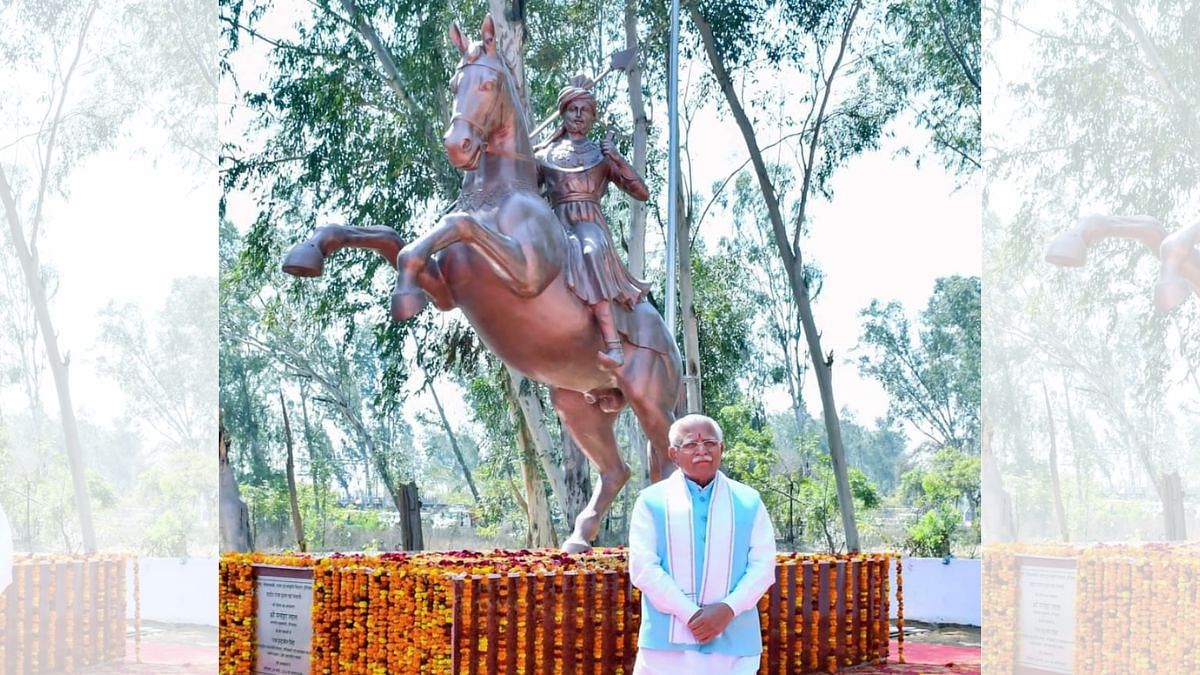The move came within months of communal violence in Nuh district, which began during a Vishva Hindu Parishad-led religious procession in July last year. Nuh district influences the electoral outcome in two parliamentary seats, Gurugram and Faridabad.
Addressing the people after unveiling the statue, Khattar praised Mewati’s valour in defending the country against the Mughals. “The nation will always honour the memory of such brave martyrs,” he said.
Rashtriya Swayamsevak Sangh (RSS) chief Mohan Bhagwat, too, has praised Mewati in the past.
Crafted by Rajasthan sculptor Naresh Kumawat with glass fibre and ‘panchdhatu‘ (five metals), the statue depicts the raja as a warrior, sitting on a horse with a spear in one hand and a sword hanging from his waist.
Khattar later posted a video and message about the statue unveiling on X, formerly Twitter.
Live: मुख्यमंत्री श्री @mlkhattar नूंह में आयोजित राजा हसन खान मेवाती शहीदी दिवस समारोह में… https://t.co/wirS2p56BP
— CMO Haryana (@cmohry) March 9, 2024
“Under the Sant Mahapurush Samman and Vichar Prachar Yojna, today I participated in the martyrdom day of Shaheed Raja Hasan Khan Mewati and paid my tribute,” Khattar said in another message on X.
संत महापुरुष सम्मान एवं विचार प्रसार योजना के तहत आज नूंह में आयोजित शहीद राजा हसन खान मेवाती के शहीदी दिवस में सम्मिलित होकर उनके बलिदान को याद किया।
आकांक्षी जिले नूंह के विकास और लोगों के जीवन स्तर में सुधार की दृष्टि से आज शिक्षा, इन्फ्रास्ट्रक्चर, स्वास्थ्य तथा खेलकूद से… pic.twitter.com/pQs9SHNdG1
— Manohar Lal (मोदी का परिवार) (@mlkhattar) March 9, 2024
Who was Hasan Khan Mewati
According to Saddique Ahmad Meo, a historian of the Mewat region, the first ruler of the Mewat dynasty was Samarpal (also Sonpal). He became close to Firoz Shah Tughlaq in 1372 after he saved Tughlaq’s life from a tiger. Named Khanzada Bahadur Nahar (tiger) by Tughlaq, he ruled till 1402.
Raja Hasan Khan Mewati was the ninth and the last ruler of the Mewat dynasty, ruling from 1504 to 1527. He was slain on 17 March 1527, fighting along Rana Sanga of Mewar against the forces of Babur. After his time, the dynasts — titled khanzadas — were reduced to Zamindars.
Mewati was born around 1491 at Tijara near Alwar in present-day Rajasthan to Khanzada Alawal Khan, the eighth ruler of the Mewat dynasty.
“Hasan Khan Mewati was of sharp intellect from early childhood. His early education was at home. He knew Hindi, Urdu, Persian, and Arabic well. Along with these languages, battle skills and ruling arts were also taught to him,” said Meo.
Mewati become a skilled horse rider and warrior. At 25, he took over the reins of power in 1516 during his father’s lifetime.
His maternal cousin, Sultan Ibrahim Khan Lodi, was Delhi’s ruler of that time. Ibrahim Lodi was so impressed with Mewati’s bravery that he conferred the title of “raja” on him.
“During his rule, Mewat was a strong state with boundaries from Delhi’s Sarai Laat to Alwar. The state’s income was 16,98,100 tanka, equal to Rs 8,49,050 per annum. However, a tempest from the western borders in the shape of an attack by Emperor Babur in 1526 altered the history of India, along with that of Mewat,” said Meo.
In the first Battle of Panipat between Babur’s forces and the Lodi empire on 21 April 1526, Raja Hasan Khan Mewati fought along Ibrahim Lodi with an army of one lakh, comprising Jats, Pathans and Meos.
However, they lost the battle by the evening. Ibrahim Lodi was martyred, Babur captured Mewati’s son Tahir Khan, and Mewati’s father Alawal Khan was found dead in his camp.
The battle decisively ended the Delhi Sultanate and established the Mughal Empire. “This defeat upset Hasan Khan Mewati badly. Babur had captured Delhi and Agra and had become the emperor of Bharat. Mewati’s son was in Babur’s custody,” said Meo.
Mewati then contacted Ibrahim Lodi’s uncle, Mehmood Lodi, and Maharana Sanga and started a plan to oust Babur from India. However, he wanted his son’s release first, said Meo.
“He sent a messenger to Babur for this purpose. Babur wanted Mewati to join him and even used both of them being Muslims as a reason why Mewati should join hands with him… However, Mewati replied that though he was Babur’s ‘Kalma-go bhai’ being a Muslim, he was a true Muslim and could not go back on his words,” Meo said.
Though “upset with Mewati’s reply”, Babur released Tahir Khan with a letter addressed to Mewati, asking him to rethink his stand and come to his side. However, soon after his son’s release, Mewati set out to meet Rana Sanga with his 12,000-strong horse-riding army.
The Rana Sanga-led forces went to war with Babur’s forces at Khanwa near Bharatpur in 1527. During the battle, Rana Sanga was injured and evacuated from the battlefield. Mewati took command but was killed when a shell from a cannon fired by Babur’s forces burst near him. Their defeat consolidated the Mughal rule for centuries to come.
Also read: Haryana budget walks path of fiscal discipline, while also providing numerous pre-election subsidies
‘Bharat Mata Putra’
Nine years ago, RSS chief Mohan Bhagwat paid tribute to Raja Hasan Khan Mewati in a speech at Khanwa near Bharatpur, where Mewati fought his last battle.
Bhagwat asserted that Rana Sanga’s warrior Hasan Khan Mewati had rejected Babur’s offer to join his army and called him ‘Bharat Mata Putra’.
On 16 October 2021, Bhagwat again named Mewati while addressing a public gathering during a Vijaydashami event in Jaipur.
Also read: 6 months after Nuh violence, Haryana Police cite UAPA against 80 accused in 3 cases

